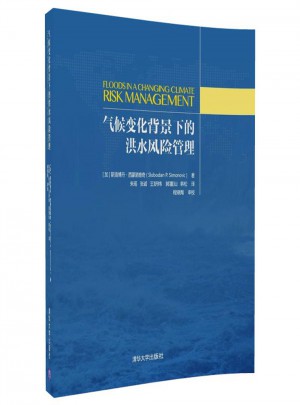

气候变化及其日趋显著的影响已成为全球共同关注与应对的重大问题。在气候变化背景下,洪水与洪灾表现出更大的不确定性,迫切需要将系统方法引入洪水风险管理,为解决防灾、减灾、应急响应与灾后重建中跨学科的系列复杂难题,提供更为适合的分析工具。本书深入浅出讲解了洪水风险管理的基本理念,论述了气候变化对洪水风险特性的影响,探讨了应对气候变化的洪水风险管理决策过程与有效措施; 进而基于系统理论与案例分析详细介绍了概率法与模糊集方法在洪水风险管理中的应用,展望了未来适应气候变化的洪水风险管理前景。本译著为相关领域科研、管理人员和大专院校师生提供了中英对照的读本,具有良好的学习与借鉴价值。
本书向人们介绍如何针对未来气候变化开展洪水风险评估,并据此及早制定更为有效的应对措施,尤其针对易于遭受洪水灾害的地区和居民。
目录|Contents
Foreword3
Preface5
Foreword7
Preface11
Acknowledgements13
Definitions15
Acronyms and abbreviations21
Chapter 1Flood risk management1
1.1The global flood problem4
1.2Problem context8
1.3Flood risk15
1.4How do we manage flood risk?17
1.5Systems view of flood risk
management19
1.6Conclusions23
1.7Exercises24
Chapter 2Climate change and risk of
flooding25
2.1Floods and their physical
characteristics27
2.2Climate change and variation
impacts35
2.3Approaches for dealing with
climate change49
2.4Conclusions55
2.5Exercises57
Chapter 3Risk management as adaptation to
climate change59
3.1Flood risk management decision
process63
3.2Approaches to flood risk management
as adaptation to climate change74
3.3An example: Climate changecaused flood
risk to municipal infrastructure,City
of London (Ontario,Canada)82
3.4Conclusions124
3.5Exercises125
Chapter 4Risk management: probabilistic
approach127
4.1Mathematical definition of risk129
4.2Classification of risk135
4.3Risk criteria138
4.4Probabilistic risk modeling141
4.5Probabilistic tools for flood risk
management147
4.6Conclusions213
4.7Exercises214
Chapter 5Risk management: fuzzy set
approach217
5.1Paradigm change219
5.2Introduction to fuzzy sets222
5.3Fuzzy risk definition241
5.4Fuzzy tools for flood risk management
under climate change249
5.5Conclusions307
5.6Exercises308
Chapter 6Future perspectives311
6.1Understanding climate change and
flood risk management313
6.2Adaptive flood risk management
under climate change316
6.3Risk communication319
6.4Conclusions323
References325
译著序言3
译者的话5
序言7
前言11
致谢13
术语15
缩略词21
第1章洪水风险管理1
1.1全球洪水问题4
1.2洪水问题的内涵8
1.3洪水风险15
1.4如何管理洪水风险17
1.5洪水风险管理的系统观点19
1.6结论23
1.7练习题24
第2章气候变化与洪水风险25
2.1洪水及其物理特性27
2.2气候变化和变异的影响35
2.3气候变化的应对措施49
2.4结论55
2.5练习题57
第3章适应气候变化的风险管理59
3.1洪水风险管理决策过程63
3.2适应气候变化的洪水风险管理
措施74
3.3案例: 气候变化导致加拿大安大略省
London市市政基础设施
洪水风险82
3.4结论124
3.5练习题125
第4章风险管理: 概率法127
4.1风险的数学定义129
4.2风险类型135
4.3风险标准138
4.4概率风险模型的建立141
4.5洪水风险管理的概率工具147
4.6结论213
4.7练习题214
第5章风险管理: 模糊集方法217
5.1模式转变219
5.2模糊集介绍222
5.3模糊风险的定义241
5.4气候变化条件下洪水风险管理中的
模糊工具249
5.5结论307
5.6练习题308
第6章未来前景311
6.1了解气候变化与洪水风险管理313
6.2气候变化背景下适应性洪水风险
管理316
6.3风险沟通319
6.4结束语323
参考文献325
第1章洪水风险管理|Flood risk management
Chapter 1Flood risk management
A flood is a very simple natural phenomenon that occurs when a body of water rises to overflow land that is not normally submerged (Ward,1978) At the same time,a flood is a very complex phenomenon that connects the natural environment,people,and the social systems of their organization Flooding causes loss of human life It damages infrastructure such as roads,bridges,and buildings,and hurts agricultural productivity because of lost crops and soil erosion Flood disaster relief often requires enormous funding Connectivity increases risksAs more links are present among the elements of natural,social,and technological systems,these systems develop unexpected patterns of connections that make breakdown more likelyWe are witnessing many catastrophic flood disasters European floods in 2002 caused more than 7 billion damage Hurricane Katrina caused flooding in 2005 that was the costliest natural disaster,as well as one of the five deadliest,in the history of the USA At least 1,836 people lost their lives in the actual hurricane and in the subsequent floods; total property damage was estimated at US$81 billion In June of 2006,northeastern Bangladesh disappeared under monsoon floods as rains drenched the region The floods stretched across hundreds of kilometers of what had been dry land a month earlier and inundated two thirds of the territory of the country Typhoon Morakot of 2009 was the deadliest typhoon to impact Taiwan in recorded history It created catastrophic damage in Taiwan,leaving 461 people dead and 192 others missing,and roughly US$33 billion in damage The storm produced huge amounts of rainfall,peaking at 2,777 mm (1093 in) The extreme amount of rain triggered enormous mudslides and severe flooding throughout southern Taiwan One mudslide buried the entire town of Xiaolin,killing an estimated 500 people In the wake of the flood,Taiwans President Ma Yingjeou faced extreme criticism for the slow response to the disaster,having initially deployed only roughly 2,100 soldiers to the affected regions Later additions of troops increased the number of soldiers to 46,000 The 2010 China floods began in early May The total death toll as of August 5 was 2,507 More than 305 million people in 28 provinces,municipalities,and regions were affected,while at least 12 million people had been evacuated because of the risk of flooding and landslides by early August As I am writing these words,Pakistans deadliest floods in decades have killed more than 1,500 people and overwhelmed government efforts to provide aid The floods death toll may rise to 3,000 Approximately 20 million people had been affected by floods by early August Regions downstream in the Indus River valley,where most of Pakistans 162 million people live,are bracing for floods that may damage crops
第1章洪水风险管理
洪水是一种非常简单的自然现象。当洪水发生时,水体水位升高淹没平常不受淹的陆地(Ward,1978)。同时,洪水也是一种非常复杂的现象,与自然环境、人类及其社会组织体系有密不可分的关系。洪水泛滥会导致人员伤亡,也会毁坏基础设施,例如道路、桥梁和建筑物等,并因土壤侵蚀、农作物受损而破坏农业生产力。减轻洪灾往往需要巨大的投入。现代社会多个系统之间的连通性使得洪水风险大大增加。随着自然、社会和科技系统中各单元之间的联系越来越多,这些系统间连接的故障就更可能呈现突发的模式。我们见证过很多大洪灾: 2002年欧洲大洪水造成70亿欧元的损失。2005年卡特里娜飓风引发的洪灾造成了最为严重的经济损失,这场灾难也是美国历史上伤亡最重的五大灾难之一。在飓风灾害和随后的洪灾中,至少有1836人死亡,总资产损失估计达到810亿美元。2006年6月,因为持续的降雨,孟加拉国东北部变成了一片泽国。洪水淹没的区域纵深达几百公里,将一个月前还安然无恙的陆地全部淹没。此次洪灾使得孟加拉国2/3的领土被淹。2009年的莫拉克台风是中国台湾有记录以来最致命的一场台风,带来了灾难性的破坏,共有461人死亡,192人失踪,经济损失达33亿美元。风暴使得降雨量激增,较大降雨量达2777 mm(1093 in)。极端降雨引发了台湾南部严重的泥石流和洪水灾害,其中,小林村整个村子都被泥石流掩埋,估计死亡500人。洪水暴发后,台湾当局领导也因对灾害救援反应迟缓而饱受批评。灾害发生后,政府仅仅出动2100名士兵前往灾区救援,难以满足救灾需求,所以又增援士兵46000人。2010年中国大陆的洪水始于5月,至8月5日死亡人数已达2507人,28个省、自治区和直辖市受灾,受影响人口达305亿人。截至8月初,中国至少有1200万人因洪水和滑坡风险而被迫撤离。就在我写这本书的时候(2010年,译者注),巴基斯坦发生了近几十年来最严重的洪灾,死亡人口超过1500人,政府的救灾努力收效甚微。洪灾导致的死亡人口总数可能将达到3000人,截至2010年8月初,受洪灾影响的人口约为2000万人。Indus河下游地区有162亿巴基斯坦人及大片的农田随时可能被洪水淹没。